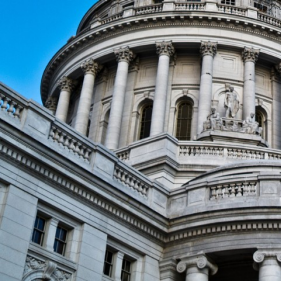By Douglas J. Elliott
This article was first published on September 28, 2020.
One lesson for financial regulation already seems clear from the Coronavirus Recession; we should restructure the capital buffers constructed by the Basel Committee on Banking Supervision. In particular, the countercyclical capital buffer (CCyB) has worked well and the capital conservation buffer (CCB) has not, in my view.
The Basel Committee should seriously consider shrinking the CCB and transferring the difference into a target level of the CCyB in normal times. For example, the CCB could be reduced from 2.5 percent of risk-weighted assets (RWA) to 1.5 percent and the CCyB could be targeted at 1.0 percent in normal times, rather than having a base of zero. However, in times like these when authorities wish to encourage lending rather than discourage it, the level of the CCyB might be kept at zero for a very considerable time before being raised to this new base.
For US readers, note that the stress capital buffer (SCB) has essentially replaced the CCB in America. My arguments here would translate into a recalibration of the SCB to be at lower levels.
There are a number of other capital requirements at the global and national levels that may reduce the impact of the CCB and CCyB, but this should not stop us from improving the design of those two buffers.
The Basel Committee should seriously consider shrinking the CCB and transferring the difference into a target level of the CCyB in normal times
THE COUNTERCYCLICAL CAPITAL BUFFER (CCYB) WORKED WELL
A number of countries were operating with positive levels of the CCyB prior to the pandemic and all of them have taken it down to zero in order to provide more capacity for lending. I have always supported the CCyB, but many observers had a concern that it would not work well in practice. First, authorities might not move quickly enough when it needs to be lowered. Second, there was a fear that the reduction would be offset by reactions from the market, microprudential supervisors, or managements themselves. The offsets would occur because heightened risk in the banking system would lead one or more of these parties to demand higher capital levels at the individual bank level, regardless of regulatory requirements.
Fortunately, in this crisis, authorities moved swiftly and there is little evidence of any offsetting factors pushing target capital levels back up. Admittedly, this buffer may work best in a situation like today’s when the economic shock is very clear, starts outside the financial sector, and does not hit banks so hard as to make them unstable. Nonetheless, the CCyB makes excellent theoretical sense and has worked well in this test.
THE CAPITAL CONSERVATION BUFFER (CCB) HAS NOT WORKED WELL
So far, the CCB is encountering the exact problems that I, and many others, warned about, which is that managements and stockholders have been extremely reluctant to use the buffer. (See my paper on Banks and the Next Recession for a longer, pre-pandemic discussion of my concerns and the impact of the CCB on economic procyclicality.) This is because of two related reasons. First, there are regulatory penalties intended to ensure the buffer is not used lightly. Second, there is a very significant stigma attached to dipping into this buffer, partly because the existence of the penalties creates a signaling effect if management uses the buffer. As a result of these issues, the CCB has rarely been utilized in this crisis, despite the urging of authorities in many countries.
Some officials argue that the CCB is working as intended, since the goal was to prevent individual banks that are suffering idiosyncratic shocks from freely reducing their capital through discretionary actions such as dividends or repurchases. Thus, the penalties serve a purpose and it is desirable that managements avoid using the buffer except when truly necessary or as the automatic effect of major losses.
However, I have talked to many more officials around the globe who have been urging their banks to use the CCB as a way to expand or maintain their lending to support the larger economy. That is, essentially treating the CCB as if it were a systemic countercyclical buffer like the CCyB. The penalties and related stigma make it very difficult to persuade managements to do this, however.
WE SHOULD TRADE SOME OF THE CCB FOR MORE CCYB
I believe maintaining a positive level of CCyB in normal times would be well worth cutting back on a CCB that has not shown significant value as a policy tool. To be clear, the CCyB would be raised or lowered from this base level depending on the same macroprudential factors that are considered today.
THE COUNTERARGUMENTS
Some will argue that the CCB was designed for a different purpose and therefore has not really been tested in this crisis. They might add that my arguments for increasing the CCyB are good, but do not explain why the CCB should be reduced. This is a fair argument for those who want the CCB to be purely a microprudential tool for idiosyncratic problems at individual banks, as opposed to the many officials trying to use it countercyclically today.
My response is two-fold. First, aggregate required capital levels in the system appear to be about right, so we should find an offset if we want to make the normal level of the CCyB positive. (This is what the UK did earlier when they chose to target a CCyB of one percent in normal times while reducing other requirements by the same amount.) Admittedly, as I pointed out in my recent paper, Lessons in Financial Regulation from the Coronavirus Recession, no one knows the precise right level of capital requirements and there are reasonable arguments for raising or lowering the aggregate by as much as a fifth. However, if one disagrees with my assessment of appropriate aggregate capital levels, it would be better to fix this by revising the base requirements, which still leaves room for the changes to the two buffers I advocate here.
Second, the CCB appears to be the best place to find that offset, as its policy benefits do not appear large to me.
Others may argue that we should wait until the current crisis has played out before we start revising the Basel rules. Maybe we will find the CCB operates better than I think or there may be some more complex trade-offs that should be made once we consider all the regulatory changes that may be needed.
My response is that I believe the buffer lessons are already clear. Further, making the change in the near future would also reduce the fear that banks and their investors harbor that any use of the CCB now will require too fast a restoration of capital afterwards. The CCyB, for its part, is clearly tied to the state of the financial system while the CCB was designed to be static. Therefore, regulators could sensibly phase in the new positive target for the CCyB based on economic recovery and the state of the financial system. This would be possible on an ad hoc basis with the CCB, but is considerably more awkward and may face legal constraints, especially in Europe.
Still others may simply distrust the CCyB and fear that it will prove a flawed instrument in other circumstances even if it worked well in the current crisis. My detailed responses to that are too long for this paper, so suffice it to say for now that the CCyB makes great theoretical sense to me and came through this crisis with flying colors. I have expanded on the theoretical arguments in multiple previous papers.
CONCLUSION
This is a regulatory trade that would be well worth making and I believe it warrants consideration now, rather than awaiting the end of this crisis period.
Douglas Elliott is an Oliver Wyman partner focused on the intersection of Finance and public policy, particularly financial regulation. Prior to his current position, he was a scholar at the Brookings Institution and a Visiting Scholar at the IMF. He began his career with two decades as an investment banker, primarily at JP Morgan. He has written extensively on capital standards for the IMF, Brookings, and Oliver Wyman..






.jpg.imgix.fourColumnTile.jpg)




